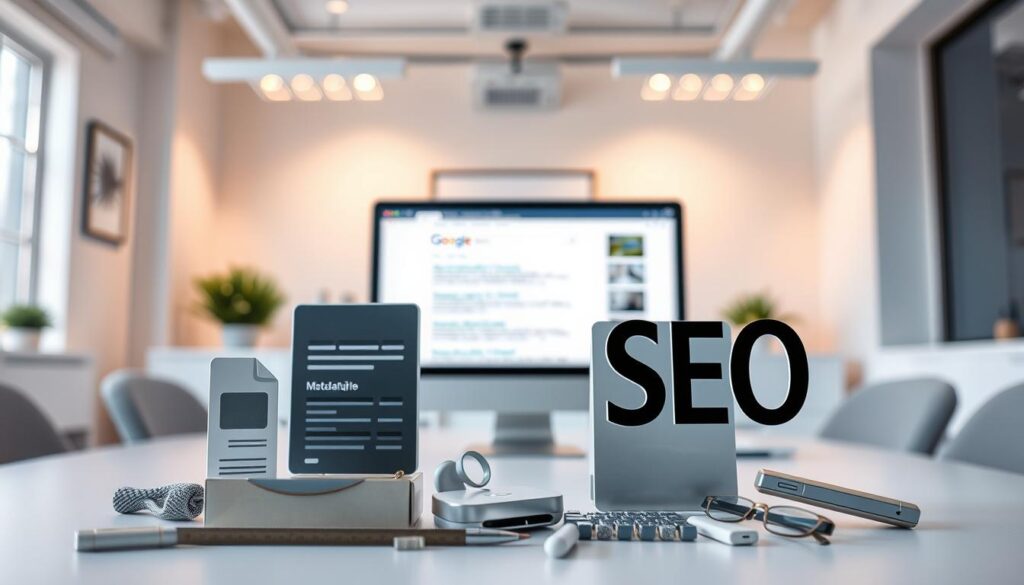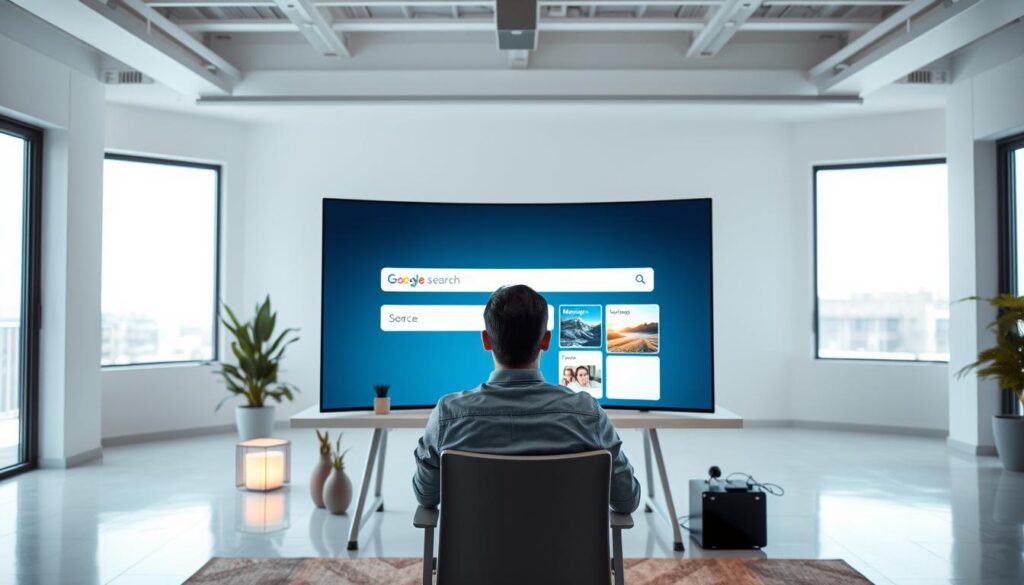Robiz Solutions says traditional text-based optimization is outdated. Businesses must now focus on multimodal optimization to keep up with AI.
Google Lens and AI queries are changing how companies work online. They need to adjust their strategies to handle multimodal inputs.
This change is key for businesses to succeed online. It’s vital to know how to optimize for a multimodal world.
Key Takeaways
- Understand the concept of multimodal optimization and its growing importance.
- Learn how Google Lens impacts your online presence.
- Discover strategies to optimize for AI-driven queries.
- Stay ahead by adapting to the changing digital landscape.
- Enhance your business’s visibility with effective multimodal optimization.
Understanding Multimodal Search SEO
Multimodal search SEO is changing how we use search engines. It mixes text, images, and voice queries. This shift is key for businesses to keep up with search engine optimization.
Definition of Multimodal Search
Multimodal search lets search engines handle text, images, and voice. Experts say it combines voice, text, and visuals for a better search. This makes searching more natural and easy for users.
Importance of Multimodal Search in SEO
Multimodal search is vital for SEO. As search engines get smarter, businesses need to adjust their SEO. They must optimize for text, voice, and visual searches.
By using multimodal SEO, businesses can reach more people. This boosts their online presence.
Differences Between Traditional and Multimodal Search
Traditional search focuses on text. Multimodal search adds images and voice. This change makes search more dynamic and interactive.
For example, users can search with voice and then refine with an image. This wasn’t possible before, showing how multimodal search has advanced.
Key Takeaways:
- Multimodal search combines text, images, and voice queries.
- It provides a more intuitive search experience.
- Businesses must adapt their SEO strategies for multimodal queries.
As Google Lens and visual search tech evolve, multimodal SEO’s role will grow. Businesses that adapt will thrive in the digital world.
The Impact of Voice Search on Multimodal SEO
Voice search is changing how we do SEO. More people use Siri, Google Assistant, and Alexa. This makes voice search optimization key for businesses to lead in SEO.
Trends in Voice Search Usage
Voice search is getting more popular. Over 58% of people use it to find local businesses. This shows a big change in how we search, with voice search becoming more common.
Some key trends in voice search include:
- Increased use of natural language queries
- Greater emphasis on local search results
- Rise in voice-activated device usage
Best Practices for Voice SEO
To get better at voice search, follow these tips:
- Use Natural Language: Make your content sound like how people talk in voice searches.
- Focus on Local SEO: Make sure your business is right on local directories and Google My Business.
- Improve Page Loading Speed: Fast websites are better for everyone, but voice search users need them most.
Integrating Voice Search into Your Strategy
To add voice search to your SEO plan, know what users want. This means:
- Using long-tail keywords that match voice search queries
- Creating content that answers questions directly
- Ensuring your website is mobile-friendly and accessible
By using these methods, businesses can show up more in voice search. This keeps them ahead in the SEO world.
Optimizing Images for Multimodal Search
Image optimization is key in multimodal SEO. It helps your content get found and keeps users interested. With tools like Google Lens, visual content plays a big role in search results.
Importance of Image SEO
Image SEO is essential for your visual content to be found online. It can bring a lot of traffic to your site. Optimizing images makes your site more visible and improves user experience.
Techniques for Image Optimization
Here are some ways to optimize images for multimodal search:
- Choose high-quality, relevant images that match your content.
- Compress images to make them smaller without losing quality. This speeds up your site.
- Use file names that include your target keywords.
- Implement lazy loading to load images only when needed.

Using Alt Text and Captions Effectively
Alt text and captions are important for image SEO. Alt text helps search engines and users understand the image. Captions add more context and boost user interaction. Effective use of alt text and captions can greatly improve your image SEO.
| Optimization Technique | Description | Benefit |
|---|---|---|
| Descriptive File Names | Use target keywords in file names. | Improves search engine understanding of image content. |
| Alt Text | Provide a description of the image. | Enhances accessibility and search engine optimization. |
| Captions | Offer additional context to the image. | Improves user engagement and understanding. |
By using these strategies, you can boost your image SEO. This makes your content more discoverable and enhances your overall SEO efforts.
Creating Content for Text and Voice Queries
In today’s world, making content that works for many platforms is key. Businesses need to know how to reach users through text and voice. This is vital for a strong online presence.
Understanding User Intent
User intent is the core of good content. Voice searches are often like talking to a friend, asking questions. So, businesses must make content that fits how users ask their questions.
- Find out what questions people have about your business or field.
- Use tools like Google Trends and Keyword Planner to see what users are looking for.
- Create content that answers these questions directly.
Structuring Content for Natural Language Processing
Natural Language Processing (NLP) is important for voice search. To do well with NLP, content should be written like we speak.
Here are some tips:
- Write in a friendly, conversational style.
- Organize content with clear headings and subheadings.
- Include FAQs to answer common questions.
Incorporating Long-Tail Keywords
Long-tail keywords help find specific searches, like those in voice queries. They’re longer and more conversational, making them less competitive and more focused.
To use long-tail keywords well:
- Do deep keyword research to find the right phrases.
- Put these keywords naturally into your content, in headings and subheadings.
- Use them in meta tags and descriptions too.
By getting user intent, making content for NLP, and using long-tail keywords, businesses can improve their visibility in both text and voice searches.
The Role of Machine Learning in Multimodal Search
Machine learning is key in making multimodal search better. Search engines are getting smarter, thanks to machine learning. This makes search results more accurate and relevant.

Enhancing Search Results with Machine Learning
Machine learning makes search results better by understanding what users mean. This is vital in multimodal search, where users use text, images, and voice.
Large language models (LLMs) and vision language models (VLMs) are important here. LLMs get text queries, and VLMs interpret images. This makes search results more accurate and relevant.
“The future of search is not just about text; it’s about understanding the world in a more human way, through images, voice, and text.”
Adapting to Algorithm Changes
Search engines keep updating their algorithms with new machine learning tech. SEO strategies need to keep up with these changes to stay effective.
- Stay updated on machine learning and SEO news
- Change content strategies with new algorithm updates
- Create high-quality, relevant content that meets user needs
Future Trends in Machine Learning and SEO
The future of multimodal search SEO is linked to machine learning progress. With Google Lens search and other visual search tech getting popular, knowing how to optimize for them is key.
Future trends include AI in search engines understanding user behavior better. This will lead to more personalized search results.
Implementing Structured Data for Multimodal Search
Structured data is key for multimodal search optimization. It helps search engines understand your content better. This makes your website more visible in search results.
What is Structured Data?
Structured data is a standardized way to add extra information to webpages. It’s done through schema markup, a code in your webpage’s HTML.
Schema markup helps search engines like Google get your content’s context. For example, it can highlight a recipe’s ingredients and cooking time.
Benefits of Using Schema Markup
Schema markup has many benefits for SEO. It makes content easier for AI to understand, improving search rankings. Key advantages include:
- Improved search engine rankings
- Enhanced content visibility in search results
- Better understanding of content by search engines
- Increased click-through rates due to rich snippets
A top SEO expert says, “The future of SEO is making content understandable by machines.” This highlights schema markup’s role in making your content machine-readable.
“Schema markup is a powerful tool that can significantly enhance your website’s visibility in search results.”
How to Implement Structured Data
To add structured data, you need to add schema markup to your HTML. Here’s how:
- Identify your webpage’s content type
- Choose the right schema markup for it
- Add the markup to your HTML
- Use Google’s Structured Data Testing Tool to test it
| Content Type | Schema Markup Type | Benefits |
|---|---|---|
| Recipes | Recipe schema | Rich snippets with cooking time and ingredients |
| Events | Event schema | Display event details in search results |
| Reviews | Review schema | Show review ratings in search results |

Effective use of structured data boosts your website’s visibility and ranking. This drives more traffic to your site.
Enhancing User Experience for Multimodal Search
Improving user experience is key for businesses aiming to boost their SEO for multimodal search. With more people using voice and visual searches, it’s important to make experiences smooth across various devices and ways of searching.
Mobile Optimization
Most voice and visual searches happen on mobiles. So, mobile optimization is a must for multimodal search SEO. A site that works well on mobiles lets users find what they need easily, no matter their device.
Fast Loading Times and User Engagement
Fast websites keep users interested. Slow sites can cause people to leave quickly, hurting your SEO. It’s important for your site to load fast on both desktops and mobiles.
Accessibility Considerations
It’s not just good practice but often the law to make your site accessible to everyone. This means clear navigation, alt text for images, and working with assistive tech.
| Characteristic | Optimized Website | Non-Optimized Website |
|---|---|---|
| Mobile Optimization | Responsive design, easy navigation | Not mobile-friendly, difficult navigation |
| Loading Time | Fast (less than 3 seconds) | Slow (more than 5 seconds) |
| Accessibility | Accessible, alt text for images | Not accessible, missing alt text |

By focusing on mobile optimization, fast loading, and accessibility, businesses can greatly improve the user experience for multimodal search. This leads to better SEO results.
Utilizing Video Content for Multimodal SEO
Video content is key in multimodal SEO, engaging users and boosting search rankings. As search engines grow, adding video to your SEO plan is vital to stay ahead.
The Rise of Video in Search
Video content’s popularity has soared, with YouTube now the second-largest search engine. This change means search engines value video more, impacting SEO.
A study found video content is 50% more likely to drive organic traffic than text. This makes video a must for businesses wanting to be seen online.
“Video content is king when it comes to engaging users and driving conversions. By incorporating video into your SEO strategy, you can significantly enhance your online presence.”
Best Practices for Video SEO
To get the most from video SEO, follow these best practices:
- Use descriptive titles and keywords in your video metadata.
- Optimize your video descriptions with relevant keywords and links to your website.
- Utilize tags to help search engines understand your video’s content.
- Create thumbnails that are eye-catching and match your content.
- Make sure your videos are mobile-friendly and quick to load.
| Video SEO Practice | Description | Benefit |
|---|---|---|
| Descriptive Titles | Use relevant keywords in your video title. | Improves search engine understanding of your content. |
| Optimized Descriptions | Include keywords and links to your website. | Enhances video visibility and drives traffic to your site. |
| Relevant Tags | Use tags that accurately describe your video content. | Helps search engines categorize your video correctly. |
Tips for Creating Engaging Video Content
Creating engaging video content is key to keeping viewers interested. Here are tips for making high-quality videos:
- Know your audience and tailor your content to their interests.
- Use high-quality visuals and audio to enhance the viewing experience.
- Keep your videos concise and to the point.
- Promote your videos across multiple platforms to maximize reach.
- Encourage viewer engagement through calls-to-action.
By using these strategies, you can boost your multimodal SEO and drive more traffic to your site.
Analyzing Competitors in Multimodal Search
To stay ahead in multimodal search SEO, analyzing your competitors is key. Knowing their strategies and performance offers valuable insights. This helps optimize your own content.
Identifying Top Competitors
Finding your top competitors is the first step. Look for keywords related to your content and check the top-ranking pages.
Key factors to consider when identifying competitors include:
- Keyword overlap
- Content relevance
- Search engine ranking positions (SERPs)
Knowing your competitors lets you analyze their strengths and weaknesses.
Tools for Analyzing SEO Performance
Many tools can help analyze competitor SEO performance. Here are a few:
| Tool | Description | Key Features |
|---|---|---|
| Ahrefs | Comprehensive SEO toolset | Keyword analysis, backlink analysis, content analysis |
| SEMrush | Digital marketing tool | Competitor analysis, technical SEO audits, keyword research |
| Moz | SEO toolset | Keyword research, link building, content optimization |
These tools give insights into competitor keyword strategies, backlinks, and content performance.
Learning from Competitor Strategies
Studying competitor strategies can show you how to improve and innovate. By seeing what works for them, you can make your multimodal search SEO better.
Best practices for learning from competitors include:
- Analyzing their content structure and format
- Understanding their keyword targeting and density
- Examining their use of multimedia elements
By using these insights, you can boost your multimodal search SEO performance.
The Importance of Local SEO in Multimodal Search
Local SEO is key in today’s world of voice search and image queries. As more people use multimodal search to find local businesses, it’s critical for companies to boost their online presence.
Optimizing for Local Searches
To shine in local searches, businesses need to make sure their website and online listings show their brand and location well. This means claiming and optimizing Google My Business listings and keeping other local directories consistent.
Also, creating content that speaks to the local audience is important. Use geographic keywords and phrases that match your location and services.
Voice Search’s Role in Local SEO
Voice search has changed local SEO, with over 58% of consumers using it to find local info. Businesses must make their content ready for voice search queries, which use natural language and long-tail keywords.
Use long-tail keywords like “near me” or “open now.” Also, make sure your website works well on mobile devices and loads fast.
Encouraging User Reviews and Engagement
User reviews and engagement are vital for local SEO. They help build trust and credibility. Businesses should encourage their customers to leave reviews on Google My Business and other platforms.
Also, engaging with customers on social media and other online spaces is important. Respond to reviews and comments quickly and professionally.
Mobile Optimization Strategies
In today’s world, mobile optimization is key for businesses to keep up. More and more people use their phones to search, shop, and connect with brands. So, making sure your mobile experience is smooth is essential.
Ensuring Mobile-Friendly Content
Creating content for mobile is more than just making your website smaller. It’s about making your message clear and quick on phones. Use short, punchy paragraphs and optimize your media for fast loading on slow networks.
“The mobile user experience is a critical factor in determining the success of your multimodal search strategy,” says a leading expert in SEO. “By prioritizing mobile-friendly content, you can improve user engagement and drive conversions.”
Responsive Design Principles
Responsive design is the core of a good mobile strategy. It makes your website work well on all devices, no matter how users access it. Important parts include flexible grids, images, and media queries.
- Use flexible grids to create a layout that adjusts to different screen sizes.
- Optimize images to load quickly and scale appropriately.
- Implement media queries to apply different styles based on device characteristics.
The Role of AMP (Accelerated Mobile Pages)
AMP is a project to make mobile web pages load faster and smoother. By using AMP, businesses can make their mobile experience better. This leads to improved engagement and higher conversion rates.
A recent study found that AMP can cut bounce rates and boost page views. This can really help your business’s bottom line.
Future Directions of Multimodal Search Optimization
Multimodal search optimization is on the verge of a new era. This is thanks to advancements in AI and machine learning. It’s important to understand these future directions to stay ahead in SEO.
Anticipated Changes in Search Algorithms
Search algorithms are getting smarter. They can now handle more complex inputs. SEO strategies will need to adapt by focusing on content for various media types, like text, images, and voice.
Key changes to anticipate include:
- Increased emphasis on natural language processing (NLP) for better understanding user queries.
- Better integration of visual search capabilities, allowing users to search using images.
- Enhanced voice search functionality, making it easier for users to find information using voice commands.
The Growing Influence of AI in Search
AI is becoming more important in search engine development. It helps make search results more accurate and personalized. The role of AI in multimodal search will continue to expand, affecting SEO strategies.
The impact of AI on search includes:
| AI Application | Impact on Search |
|---|---|
| Personalization | AI algorithms can personalize search results based on user behavior and preferences. |
| Improved Search Results | AI can enhance the relevance and accuracy of search results, making it easier for users to find what they’re looking for. |
| Enhanced User Experience | AI-driven features like voice and visual search can significantly improve the user experience, making search more intuitive and interactive. |
Preparing for Voice and Image Search Trends
Voice and image search are becoming more popular. It’s key to prepare your SEO strategy for these trends. This means optimizing your content for voice queries and ensuring your images are properly tagged and indexed.
By understanding and adapting to these future directions, businesses can stay ahead in the ever-evolving landscape of multimodal search optimization.
Conclusion: Embracing Multimodal Search for SEO Success
Search engines are getting smarter, and we need to keep up. They now use text, images, and voice to understand what we’re looking for. Businesses must learn to work with these new ways of searching.
Key Takeaways for Marketers
Marketers should make content for all kinds of searches. This means making images better, using special data, and writing for voice searches. Doing this helps businesses be seen more online and stay on top in SEO.
Continuous Learning and Adaptation
Businesses need to keep learning and changing with search trends. Keeping up with new search methods helps marketers improve their strategies. This way, they can get better results and stay ahead.
Staying Ahead in SEO with Multimodal Techniques
To lead in SEO, businesses should use new search methods. This includes using smart tech, focusing on local searches, and adding videos. By using these methods, marketers can succeed in SEO and grow their online presence.
FAQ
What is multimodal search and how does it differ from traditional search methods?
Multimodal search uses text, images, and voice to find what you need. It’s different from old ways that only used text.
How does voice search impact multimodal SEO?
Voice search changes how we talk to search engines. Businesses must update their SEO to include voice search.
What is the importance of image SEO in multimodal search?
Image SEO helps your pictures show up in searches. It brings more visitors to your site.
How can I optimize my content for both text and voice queries?
To make your content work for text and voice, know what people are looking for. Use natural language and long-tail keywords.
What role does machine learning play in multimodal search?
Machine learning makes search results better in multimodal search. It’s getting even more important as time goes on.
How can I implement structured data for multimodal search?
Use schema markup for structured data. It gives search engines more info about your content, making it easier to find.
Why is mobile optimization important for multimodal search?
Most people search on their phones. A website that works well on mobiles helps your search rankings and user experience.
How can I utilize video content for multimodal SEO?
Optimize your videos with the right keywords and tags. Make your videos interesting to keep your audience engaged.
What is the importance of local SEO in multimodal search?
Local SEO helps your business show up in local searches. It brings more people to your physical store.
How can I analyze my competitors in multimodal search?
Find your main competitors and check how they do SEO. Learn from them to boost your own SEO.
What are the future directions of multimodal search optimization?
Expect changes in search algorithms and more AI in search. Also, get ready for more voice and image searches.
How can I stay ahead in SEO with multimodal techniques?
Keep up with new trends and best practices in multimodal SEO. Use this knowledge to improve your SEO strategy.
